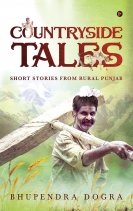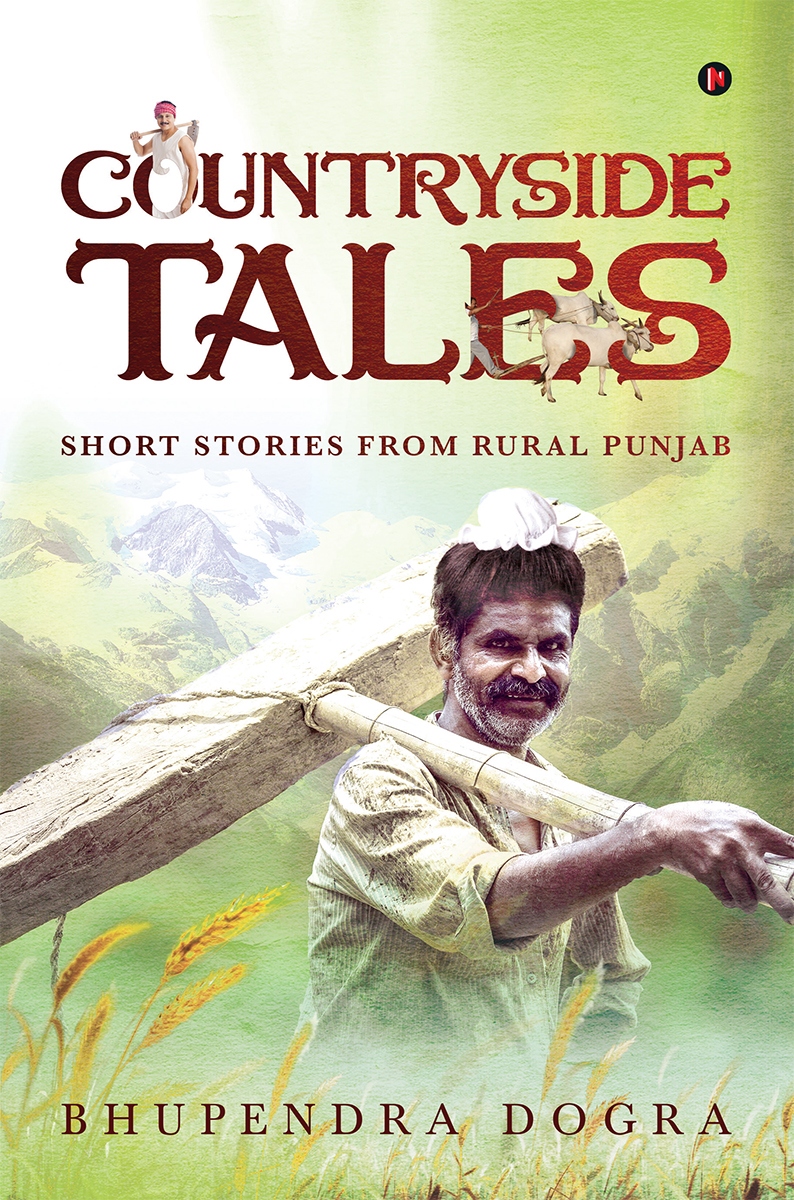
Toolbar


Literature & Fiction | 27 Chapters
Author: Bhupendra Dogra
“An interesting literary journey back in time, capturing — within the breathtaking stories — the joys and sorrows, thrills and disappointments of growing up in rural Punjab.” “Bhupendra’s stories bring out the simplicity, sensibilities, vibrancy, languor, humour and irony in lives from the Punjab countryside.” “Countryside Tales is the closest you can get to the Malgudi Days of Punjab.” “Bhupendra’s powerful narratives trans....
INTRODUCTION
I have dabbled in writing from the age of nine, narrating anecdotes and capturing the idiosyncrasies and quirks of people who fascinated me, through my word pictures and descriptions. But even in my wildest dreams, I had never imagined compiling my writings into a full-fledged book. Countryside Tales is an attempt to showcase life in rural Punjab, as seen through the eyes of a sensitive boy in his journey from childhood to youth.
I was born in a village, and though I was educated in some of the best educational centres of the country, I never lost contact with either the village or its simple and rustic inhabitants. In a sense, my constant travel outside the village and intermittent return to its folds gave me an observer’s perspective, which has helped in adding significant detail to the stories that I might have otherwise missed.
For me, the terrain of my village along with its peripheral area was nothing short of a geographical anomaly. Cradled between the river Beas in the northeast and the river Ravi in the southwest, the northern flank is marked by the high-rise Dhauladhar range of the Himalayas. On clear nights, one can see shining lights from the hill stations of Dalhousie and Dharamsala, which are actually a good 120 kilometres away. The region between the village and the river Beas sports a thick, elephantine growth of wild grass, used by the poor weavers of the village to make ropes. Towards the southeast are sandy dunes, followed by an elevated plateau that has some of the most fertile lands in the area. Beyond the plateau, at a distance of three kilometres, flows the Upper Bari Doab canal, originating from the river Ravi and meandering through the chequered landscape to finally merge into the river Chenab, somewhere in Pakistan.
Apart from a few land-owning families, the villagers are primarily farmers who till the land of the owners. With time, changes have also taken place in the means of livelihood of the village folk. A number of adult males have migrated to towns and cities in search of jobs and send back money home, which has improved the economic condition of many villagers. The village was first electrified only in the early 1960s, and tarred roads made their appearance only in the late 1970s. Tongas (horse-drawn carriages), cycles, horses and bullock carts were the main modes of transport till 1990. Most families in the village followed the joint family or extended joint family mode. The elderly commanded considerable respect in society, and often people would approach my grandfather to get their disputes settled.
In the course of my education and work, I have travelled across the country and absorbed the multi-cultural norms of life in India, but an essential part of my psyche has continued to live in the rustic lanes of the village. The stories and anecdotes in this book are about the activities of the common folk from the village, their hopes and disappointments, their beliefs and superstitions, and are based on actual people and incidents. Some of the stories have been drawn from the real-life experiences of my friends from rural Punjab. By and large, I have remained faithful to the actual happenings in the lives of various characters portrayed in the stories. Creative liberty has been taken in only a very limited manner, to enhance the impact of characterization and events.
SECTION 1
FRAGRANT IMAGES
Tales of family and other vibrant village folk
1
RIVER GANGA’S GIFT OF LIFE
It was an early October evening in the year 1933. The evening shadows had begun to crawl up the walls of the dilapidated structures that surrounded the patch of open space that served as a bus station in the holy town of Haridwar, Uttar Pradesh. A thin veil of mist, indicating the onset of early winter, had enveloped and darkened the area, compelling the shopkeepers and adjoining residents to bring out their lamps and lanterns.
For the majority of pilgrims visiting Haridwar, the preferred mode of travel in the fourth decade of the century was still the horse or the bullock-cart. The moderately affluent (who could afford the tickets) had begun to use the rudimentary motor transport service introduced by the then government in North India. The very poor and faithful however, continued to make it to the pilgrim town on foot, regardless of the distance involved.
At age 30, Gurbaxmal — who was married with two daughters — was the seventh generation paandaa (local term for Hindu priest) of the Agnihotri clan, which had been settled in the vicinity of the River Ganges for more than 150 years. Gurbaxmal was pacing up and down anxiously, awaiting the arrival of the bus from Lahore, which was to bring in a load of pilgrims from the northern towns of Punjab. Among those passengers was a 25-year old lady named Yashwanti Devi, the daughter-in-law of one Hari Ram, a prosperous farmer of Mukerian, a small town on the Jalandhar-Pathankot highway. Gurbaxmal had been given the key responsibility of receiving Yashwanti Devi and her four-year-old daughter, house them in the Vrindavan Dharamsala (a lodge), and ensure that they were able to take a dip in the sacred waters of River Ganga early the next morning — no mean task by any standards, particularly given the surging crowds on the banks of the fast-flowing river. Gurbaxmal’s ancestors had been the family priests of Hari Ram’s forefathers for many generations, so Gurbaxmal felt a sense of personal loyalty towards the lady and her child.
Just as the darkness got thicker, a faint roar of a motor engine could be heard from a distance. There was a buzz of excitement among the porters, paandaas and the lodge assistants, who were all hopeful of bagging a customer or two from the passengers travelling by bus. As the public vehicle came into view, the buzz grew into yelling and shouting, as the crowd ran hither and thither to beat the competition and acquire customers.
To say that the bus was crowded would be an understatement. It was overloaded, with more people packed on top of the roof than there were inside. Bus travel was still very much a novelty in those days, and as any bus would near Haridwar town, many of the locals — mostly rowdy youth from the suburban roadside habitations — would chase the bus and often grab the grill ladder at the back to clamber onto the roof as the vehicle slowed down at sharp curves and turns.
After the bus came to a complete halt and the noisy engine shut down, the hitchhikers on top were the first to disembark, followed by the passengers inside the bus, who started exiting through the door. Gurbaxmal spotted his guest — a graceful lady carrying a small steel trunk in her left hand and holding her little daughter with her right hand, as she guided her down the bus ramp. Gurbaxmal led the duo to the lodge where they were to spend the night.
Next morning, at 5 a.m. sharp, Gurbaxmal was at the door of the Vrindavan Dharamsala to escort his guests to Hari ki Paudi, the famous bank of the River Ganges where the faithful gathered every day to take a dip in its holy waters. The little girl, despite her tender age, appeared very excited and keen to go through the ritual. Even at that very early hour, a sizable crowd had collected at the Gangaghat. Gurbaxmal led his guests to the area where only ladies and young children were allowed. This area was secluded from the peering eyes of male bathers. He stayed back on the main platform from where the stairs went down towards the river, and urged Yashwanti Devi to walk down carefully and take a dip at the first submerged step of the ghat.
Holding her daughter’s hand tightly in her own right hand, Yashwanti Devi stepped down gingerly step by step till she reached the uppermost level of the splashing water. There were several other ladies and children going through a similar ritual. Yashwanti Devi stopped at the corner of the final steps and made her daughter stand to her right, grabbing her little hand firmly. With her left hand, she grasped the iron chain that was fixed to the upper platform to enable bathers to save themselves from being swept away by the strong currents of the river. She asked her daughter to remain on the first step and hold the chain with her fingers. Yashwanti Devi trod onto the next submerged step and took a quick dip in the fast-flowing water of the river. She quickly stepped back onto the first step and encouraged her daughter to take a similar dip, while still holding the little one’s hand tightly in her own.
As the little girl carefully followed her mother’s instructions, a powerful surge of water suddenly hit the duo from an unseen direction. Despite her best effort, Yashwanti Devi lost her hold on her daughter’s hand, and the force of the current swept the little girl away and carried her into deeper waters.
“Noooo! Save my daughter!” Yashwanti Devi let out a heart-rending cry for help, but her voice could hardly be heard over the noisy chants and boisterous cries of ‘Har har Gange’ by the bathers at the ghat.
The ever alert and faithful Gurbaxmal had seen the entire incident from his position on the approach platform. Without a moment’s hesitation, he rushed down the slippery steps of the ghat and dove into the river. The little girl was struggling in the surging water. Even as the rushing waters swiftly began to carry her further downstream, Gurbaxmal managed to reach out and grab the girl by her frock. Clutching the child, he somehow managed to swim against the current and back to the ghat. The little girl had swallowed a considerable amount of water. She was immediately laid face down on the dry surface, and pressure was applied on her back. Some of the excess water spilt out of her mouth, and she began to recover.

Literature & Fiction | 27 Chapters
Author: Bhupendra Dogra
Support the author, spread word about the book to continue reading for free.
Countryside Tales
Comments {{ insta_features.post_zero_count(insta_features.post_comment_total_count) }} / {{reader.chap_title_only}}
{{ (txt.comment_text.length >= 250 ) ? txt.comment_text.substring(0,250) + '.....' : txt.comment_text; }} Read More
{{ txt.comment_text }}
{{txt.timetag}} {{(txt.comment_like_count>0)? txt.comment_like_count : '' }}{{x1.username}} : {{ (x1.comment_text.length >= 250 ) ? x1.comment_text.substring(0,250) + '.....' : x1.comment_text; }} Read More
{{x1.comment_text}}
{{x1.timetag}} {{(x1.comment_like_count>0)? x1.comment_like_count :''}}{{x2.username}} : {{ (x2.comment_text.length >= 250 ) ? x2.comment_text.substring(0,250) + '.....' : x2.comment_text; }} Read More
{{x2.comment_text}}
{{x2.timetag}} {{(x2.comment_like_count>0)?x2.comment_like_count:''}}